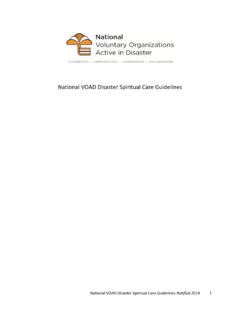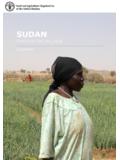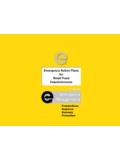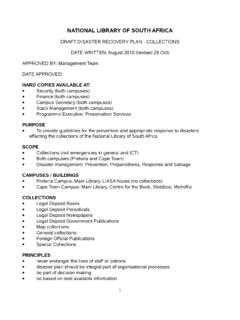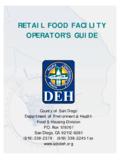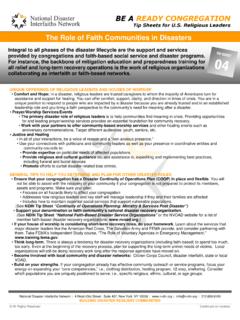Transcription of 1.8. Flow Charts for Emergency Management
1 WHO/EHA. Emergency HEALTH TRAINING PROGRAMME FOR AFRICA. 1. Overview Flow Charts for Emergency Management Panafrican Emergency Training Centre, Addis Ababa, July 1998. WHO/EHA/EHTP Draft 1-1999. Flow Charts for Emergency Management Overhead Transparencies Disasters and Health, General Flow chart Earthquake and Disaster Response, Flow chart Drought and Health Response, Flow chart Floods and Health, Flow chart Landslide and Health, Flow chart Volcanic Eruption and Health Response, Flow chart Epidemic Emergencies, Flow chart Fires and Health, Flow chart Food and Emergencies, Flow chart Violence and Public Health, Flow chart Displacement and Health, Flow chart Refugee and Internally Displaced Populations, flows , Occasions and Priorities for Assistance Essentials for Contingency and Preparedness Planning for the Health Sector, Summary , Essentials for Contingency and Preparedness Planning for the Health Sector, Hand out WHO/EHA/EHTP Draft 1-1999.
2 Flow Charts for Emergency Management Trainers' Guide Objectives: To show that Epidemiology is relevant to Emergency Management ; to clarify causal chain in disasters; to highlight elements of health preparedness and response. (Knowledge/Attitudes). Key-message: One can plan for Emergency Management , on the basis of good sense. Disasters and Health, General Flow chart Introduce. This is a frame, which can be filled for any disaster. The result is a plan for health response activities. Each Emergency has specific implications for the health sector, direct and indirect. Direct impact of floods is drowning and trauma. Indirect impact can be a diarrhoea outbreak due to pollution of water sources. Associated factors will be the displacement of population and the destruction of infrastructures that will hamper the delivery of health care. Health Response must consider all these different issues. Earthquake and Disaster Response, Flow chart (Present and discuss).
3 Drought and Health Response, Flow chart (Present and discuss). Floods and Health, Flow chart (Present and discuss). Landslide and Health, Flow chart (Present and discuss). Volcanic Eruption and Health Response, Flow chart (Present and discuss). Epidemic Emergencies, Flow chart (Present and discuss). Fires and Health, Flow chart (Present and discuss). Food and Emergencies, Flow chart (Present and discuss). Violence and Public Health, Flow chart (Present and discuss). Displacement and Health, Flow chart (Present and discuss). Refugee and Internally Displaced Populations, flows , Occasions and Priorities for Assistance Present and discuss. Population displacement caused by whatever hazard. All the phases are present. The response activities are shown in the boxes with round edges. Health care can be delivered in different measure and in different ways at all stages. Essentials for Contingency and Preparedness Planning for the Health Sector, Summary Explain.
4 The summary can be shown in transparency, while the two- page table is distributed as handout. Underline the difference between the Primary Hazard', the Transport Incident, and the Primary Cause of Death or Illness', the Trauma. Clarify WHO/EHA/EHTP Draft 1-1999. that the first responsibility of the Health Sector is to address the Primary Causes of Death or Illness. The capacities needed can be Technical, human resources and training, and Institutional, equipment, supplies, legislation, clear procedures, etc. , Essentials for Contingency and Preparedness Planning for the Health Sector, Hand-out A two- page table, to be distributed as handout. Complementary to The health sector in Emergency Management ( ). Essential Reading: EPR Handbook for Africa, WHO/PTC, 1992. African Disaster Handbook, WHO/PTC, 1990. The Public Health Consequences of Disasters, E. K. Noji, Oxford University Press, 1997. WHO/EHA/EHTP Draft 1-1999. Disasters and Health, General Flow chart Disasters and Health HEALTH.
5 RESPONSE. DIRECT. IMPACT. VULNERA- BILITY. INDIRECT. IMPACT. DISASTER. ASSOCIATED FACTORS. HAZARD. WHO/EHA/EHTP Draft 1-1999. Earthquake and Disaster Response, Flow chart HEALTH. RESPONSE. Search and Rescue Triage Asphyxia First Aid Landslides Medical evaluation Entrapment Hypothermi Special Delivery Intensive Care Transport TRAUMA Personnel: professionals Earth and volunteers Quake incidents education, training and drills Supplies and Floods Drowning equipment Collapse Fire Burns Hospital preparedness of plans and drills structures Toxic Acute and chronic Hospital vulnerability spills intoxications assessment Protection and Acute respiratory contingency plans Dust distress Back-up systems: - Decentralized stand- Damage to Electrocution by capacities electric lines - Generators, etc. LOSS OF HEALTH. FACILITIES AND SERVICES. LOSS OF OTHER. LIFELINES SPECIAL BUDGET. WHO/EHA/EHTP Draft 1-1999. Drought and Health Response, Flow chart Drought and Health Response HEALTH.
6 Diarrhoea RESPONSE. cholera Epid. Surveillance Water Typhoid Fever Control Guidelines Shortage Skin diseases Training & supplies Staff Eye diseases, etc Nut. Surveillance Guidelines for Drought supplementation &. Malnutrition Rehabilitation Training Reduced Avitaminoses & supplies staff Crop Food Intake Failure Programme Loss of Loss of strengthening EPI, MCH, ED, H. Livestock buying Less time Information referral power and less Other access to Ilness Special plans, policies & procedure Migration Health Special budget WHO/EHA/EHTP Draft 1-1999. Floods and Health, Flow chart Floods and Health CAPACITY. Drowning FOR. HEALTH. Traumas RESPONSE. Breeding of vectors Malaria Breeding of vectors Diarrhoea Loss of production and Malnutrition stocks Loss of Destruction of shelter Other infrastructure illness Loss of access to PHC. Displacement Damage to communications &. Health Facilities WHO/EHA/EHTP Draft 1-1999. Landslide and Health, Flow chart Landslide and Health HEALTH.
7 RESPONSE. 1. Search and Rescue First Suffocation Aid Medical Evacuation Hospital Emergency care Training Personnel Trauma and Materials 2. Surveillance Guidelines Loss of shelter Displacement & for treatment and Land- and production temporary Shelter control Training slide Personnel and Materials Diarrhoea Pollution of 3. Strengthening Changes in Water Programmes: EPI, environment MCH, HIE, vector Breeding of control Rehabilitation of infrastructures Vectors Other Illness 4. Special Strategies, Plans Damage to Loss of Access and Procedures Infrastructures to Health Special Budget WHO/EHA/EHTP Draft 1-1999. Volcanic Eruption and Health Response, Flow chart HEALTH. Volcanic Eruption and Health Response RESPONSE. Search and Pyroclastic flows Rescue Triage Traumas First Aid Mud streams Burns Special Acute respiratory Lava flows distress Intensive Volcanic Asphyxiation Care Ashes Intoxication Personnel: Eruption Supplies, Suffocation equipment Gases Drowning Hospital preparedness Steam plans Earthquake People's panic Risk Mapping Vulnerability Assessment Destruction of Education and Infrastructures Information Early Warning S.
8 Evacuation and Temporary Shelter SPECIAL BUDGET. WHO/EHA/EHTP Draft 1-1999. Epidemic Emergencies, Flow chart HEALTH. RESPONSE. Epidemic Emergencies Search and Rescue Triage First Aid Specific Medical evaluation Illness & Special Delivery Outbreak Death Intensive Care of Personnel: Infectious In the professionals and voluntoors education, Disease Community training and drills Spread of Supplies and Infection equipment In Health Hospital Facilities preparedness plans and drills Hospital vulnerability assessment Protection and Risk for Health contingency plans Workers Back-up systems: Decentralized stand- by capacities Difficult Access Generators, ect. Agent Unknown SPECIAL BUDGET. WHO/EHA/EHTP Draft 1-1999. Fires and Health, Flow chart Fires and Health Capacity for Burns Health Response Smoke Asphyxiation Acute and Toxic spills Chronic Poisoning Fire Explosion Collapse of Trauma structures Panic Damage to Communications &. Health Facilities WHO/EHA/EHTP Draft 1-1999.
9 Food and Emergencies, Flow chart Drought Food and Emergencies Pests Floods Other natural Failure of hazard Production Loss of War Access to Failure of Food Political crisis Distribution Economic crisis Other man- Community's made hazard vulnerability Household's Emergency vulnerability Environmental pollution Large-scale Food Contamination Other man- made hazard WHO/EHA/EHTP Draft 1-1999. Violence and Public Health, Flow chart Violence and Public Health: scenario in complex emergencies and conflicts Occurrence IMPACT UPON HEALTH Associated Factors Attacks on Health facilities Military operations Breakdown of logistics and Destruction of communications infrastructures Loss of access to safe water Violent Mortality & Capacity Mortality of Response of the Diarrheas Global National Mortality Health WAR Displacement Camps Parasites Services Loss of Measles production & stocks Malnutrition &. deficiencies Loss of purchasing Migration power Destruction of Economic commercial crisis Reduction of network State Budget for Health Relief operations Priority to defense Tensions with donors International assistance WHO/EHA/EHTP Draft 1-1999.
10 Displacement and Health, Flow chart Displacement and Health New Hazards and greater vulnerability Loss of assets &. entitlements Natural Overcrowding Economic Crisis Disaster Poor access to water Internally Poor shelter & sanitation Demographic Displaced Pressures Poor food security People Greater Loss of social networks Risk of Environmental Crisis Illness New environment Man-made and New hazards lack of Disaster information Death Refugees Political Crisis Overload on the resources and services of the host area WHO/EHA/EHTP Draft 1-1999. WHO/EHA/EHTP Draft 1-1999. Refugee and Internally Displaced Populations, flows , Occasions and Priorities for Assistance Disaster Destruction of Flight of the infrastructures Population Individual/by Massive household Fugitives Fugitives Rescue team Fugitives move return to gather gather and into another, the area sponta- organize the existing of origin neously fugitives village Transit/ Reception by Spontaneous reception village structures settlement centre PRE-POSITION: Security ENSURE: Water/buckets/soap Cooked food BRINK IN: Food/pots/fuel Shelter /blankets Security Shelter/blankets Buckets/ soap Buckets/chlorine control sanitation Food/pots Screening/referral screening/.










